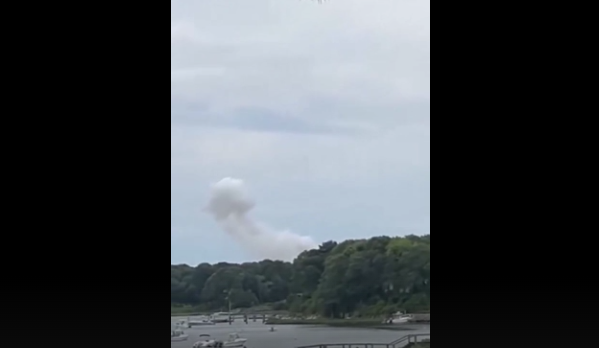Just moments after what began as routine holiday preparations at the New Seabury Golf Course in Mashpee, Massachusetts, the serenity of a summer day was violently shattered by the sudden, deafening force of a fireworks explosion. The blast, which occurred in the course’s maintenance area, left multiple individuals injured and prompted an immediate and escalating emergency response from the Mashpee Fire Department and supporting agencies. As sirens pierced the air and first responders rushed toward the source of destruction, what emerged was a chaotic and rapidly evolving scene, where the extent of injury and damage remains under active investigation.
Initial reports from emergency radio traffic and field communications indicate that the explosion occurred unexpectedly, during what may have been either preparation for a fireworks display or the handling of pyrotechnic materials near the rear operational facilities of the sprawling golf property. The New Seabury Golf Course, a coastal centerpiece of upscale leisure in Cape Cod, found itself transformed into the site of a potential mass casualty incident in seconds—a stark reminder of the danger posed by fireworks even outside traditional public displays.
Emergency responders arriving at the scene encountered “several people down,” indicating both the explosive force of the detonation and the severity of injuries involved. Authorities have not yet released precise numbers or identified the victims, but the request for additional manpower and the activation of an operational communications channel typically signals a high-acuity event. Injured individuals were likely triaged on-site, with paramedics deploying rapid trauma protocols to assess burns, blunt-force trauma, or blast injuries, all common in fireworks-related explosions.
The blast appears to have originated in or near the golf course’s maintenance zone, a less visible area of the property used by grounds crews, logistics staff, and, in some cases, third-party vendors. The nature of the explosion—fireworks-related but not part of a public display—raises critical questions about storage practices, safety oversight, and permit compliance. Was this an officially sanctioned fireworks setup for an upcoming Fourth of July celebration? Were unlicensed pyrotechnics being stored or transported improperly? These questions now lie at the heart of the investigation.
As of the time of reporting, officials have not disclosed whether the fireworks involved were consumer-grade, professional aerial shells, or illegally modified explosive materials. Each category carries its own handling risks and regulatory guidelines, but all can be deadly if mismanaged. Massachusetts has some of the strictest fireworks laws in the country—prohibiting the possession, use, or sale of consumer fireworks altogether. Only licensed professionals are allowed to transport or discharge pyrotechnics, and any deviation from those standards can carry severe legal consequences.
Given the location—an upscale golf course in a coastal resort town—the incident is especially jarring. New Seabury is known for its affluence and tranquility, a venue frequented by vacationers, retirees, and families. It is a place more often associated with quiet putting greens and seaside receptions than fire and trauma. The maintenance area, now a scene of active investigation, is likely sealed off with incident command established on-site. Investigators from the State Fire Marshal’s Office and possibly the Bureau of Alcohol, Tobacco, Firearms and Explosives (ATF), if federal statutes are implicated, may join local officials in determining the blast’s origin and accountability.
While the physical injuries sustained in the explosion remain unquantified, the psychological and communal toll is already apparent. Explosions—even accidental ones—carry a heavy emotional weight. Those present at the golf course, whether employees, guests, or bystanders, were likely sent running or ducking for cover. The detonation may have produced shrapnel from fireworks canisters or debris from surrounding structures, increasing the likelihood of secondary injuries. Fire crews would also be concerned with ignition risks: dry grass, fuel storage, and landscaping chemicals in a maintenance area create ideal conditions for fire to spread.
The Mashpee Fire Department’s decision to request an operational communications channel suggests that command-level coordination is underway, likely involving staged ambulance units, air medical resources on standby, and the notification of regional trauma centers. Triage tags, burn kits, and trauma packs would have been deployed immediately upon arriving at the scene, with the most seriously injured stabilized and transported.
For residents of Mashpee and Cape Cod more broadly, this explosion casts a long shadow over what is traditionally a time of festive preparation. July 4th events are often planned weeks in advance, and with them come safety protocols designed to prevent exactly this kind of incident. The fact that it occurred in a non-public zone and involved multiple injuries heightens concern—and raises critical questions about how fireworks were handled, stored, or potentially misused behind the scenes.
As the investigation unfolds, the public will demand answers. Were safety codes followed? Were permits in place? Who had custody of the fireworks, and what was their intended use? Were hazardous materials properly secured? And most urgently—could this have been prevented?
Until more is known, Mashpee residents and visitors will be left to speculate as helicopters hover, roads are cordoned off, and emergency lights continue to flicker against the green expanses of New Seabury. The area that was supposed to host leisure and light shows now bears the trauma of a blast site.
In the days ahead, expect statements from the Mashpee Fire Chief, local law enforcement, and possibly New Seabury management. There will be calls for reform, especially if the explosion is tied to unauthorized fireworks. If any fatalities occur, the legal and emotional weight of the incident will escalate dramatically.
For now, Mashpee waits—shaken, silent, and searching for clarity amid the echo of an explosion that should never have happened.

